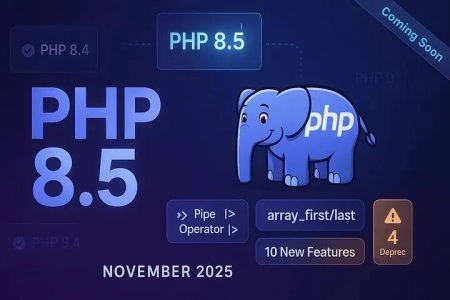PHP 8.1 中引入的 PHP Fibers 为游戏开发提供了一种令人兴奋的方法。这在游戏开发中特别有用,可用于管理渲染、物理计算、复杂模拟、AI 或实时交互等任务,以及在不阻塞主执行线程的情况下同时处理用户输入。
以下是在游戏开发中使用 PHP Fibers 的一些关键点:
- 并发性:PHP Fibers 支持并发执行任务,这对于实时游戏性能至关重要。您可以同时处理多个游戏循环、AI 计算和网络通信。
- 效率:通过暂停和恢复任务,PHP Fibers 有助于优化资源使用,确保游戏即使在复杂操作下也能流畅运行。
- 简单性:与传统的多线程不同,PHP Fiber 更易于实现和管理,从而降低了代码的复杂性。
下面是一个基本示例,说明如何在游戏循环中使用 PHP Fiber:
start();
while (true) {
// 主循环
echo "主循环迭代...\n";
$fiber->resume();
usleep(16000); // 模拟帧延迟 (60 FPS)
}上述代码中的游戏逻辑在一个 PHP Fiber 中运行,在主循环的每次迭代中都会暂停和恢复,模拟一个游戏帧。
看起来很不错,对吧? 让我们深入研究更多有趣 (实际) 的示例。
处理多个游戏实体
假设您有多个游戏实体(如玩家、敌人和 NPC),它们需要每帧更新一次。您可以使用 PHP Fibers 同时管理其更新。
name = $name;
$this->position = $position;
}
public function move($newPosition) {
$this->position = $newPosition;
echo "{$this->name} moved to position {$this->position}\n";
}
}
$entities = [
new GameEntity('Player1', [0, 0]),
new GameEntity('NPC1', [5, 5]),
new GameEntity('NPC2', [10, 10])
];
$fibers = [];
foreach ($entities as $entity) {
$fibers[] = new Fiber(function() use ($entity) {
while (true) {
$newPosition = [rand(0, 10), rand(0, 10)];
$entity->move($newPosition);
Fiber::suspend();
}
});
}
// Start all fibers
foreach ($fibers as $fiber) {
$fiber->start();
}
// Simulate game loop
for ($i = 0; $i < 5; $i++) {
foreach ($fibers as $fiber) {
$fiber->resume();
}
sleep(1); // Simulate time passing in the game
}
?>异步联网
此外,您可能需要在不阻止游戏循环的情况下处理网络通信。PHP Fibers 可以帮助管理异步网络操作。
fiber = new Fiber(function() {
while (true) {
$this->checkForMessages();
Fiber::suspend();
}
});
}
public function start() {
$this->fiber->start();
}
public function resume() {
$this->fiber->resume();
}
private function checkForMessages() {
// Simulate checking for network messages
echo "Checking for network messages...\n";
// Network logic here
}
}
$networkHandler = new NetworkHandler();
$networkHandler->start();
while (true) {
$networkHandler->resume();
usleep(16000); // Simulate frame delay (60 FPS)
}
?>游戏物理计算
您还可以使用 PHP Fibers 在其他游戏逻辑同时处理物理计算。此示例模拟基本物理特性,包括重力和摩擦力。
x = $x;
$this->y = $y;
$this->velocityX = $velocityX;
$this->velocityY = $velocityY;
$this->mass = $mass;
}
public function applyForce($forceX, $forceY) {
$this->velocityX += $forceX / $this->mass;
$this->velocityY += $forceY / $this->mass;
}
public function update() {
// Apply gravity
$this->applyForce(0, 9.8 * $this->mass);
// Apply friction
$this->velocityX *= 0.99;
$this->velocityY *= 0.99;
// Update position
$this->x += $this->velocityX;
$this->y += $this->velocityY;
}
}
$objects = [
new GameObject(0, 0, 1, 1, 1),
new GameObject(10, 10, -1, -1, 1),
new GameObject(5, 5, 0.5, 0.5, 1),
];
$fibers = [];
foreach ($objects as $object) {
$fibers[] = new Fiber(function() use ($object) {
while (true) {
$object->update();
Fiber::suspend();
}
});
}
foreach ($fibers as $fiber) {
$fiber->start();
}
// Simulate game loop
for ($i = 0; $i < 10; $i++) {
foreach ($fibers as $fiber) {
$fiber->resume();
}
// Output the positions of the objects
foreach ($objects as $object) {
echo "Object at ({$object->x}, {$object->y})\n";
}
echo "----\n";
}
?>游戏开发中的局限性?
虽然 PHP Fibers 为游戏开发提供了多项优势,但也需要考虑一些限制和挑战。
PHP 本质上是单线程的,PHP Fibers 不会改变这一点。它们允许协作式多任务处理,但不提供真正的并行性。这意味着 CPU 密集型任务可能不会看到显著的性能改进。虽然 PHP Fibers 是轻量级的,但仍然存在一些与纤程之间的上下文切换相关的开销。对于对性能高度敏感的应用程序,此开销可能是一个问题。
与传统的同步代码相比,调试基于纤程的代码可能更复杂。跟踪跨多个纤程的执行状态和流程可能具有挑战性。对于刚接触 PHP Fibers 或基于协程的编程的开发人员来说,由于学习曲线很高,因此复杂性可能会增加。了解如何有效地使用 PHP Fibers 并管理其生命周期需要一些经验和实践。
游戏开发中的 PHP 生态系统不如 C++ 或 C# 等其他语言成熟。这意味着专为游戏开发量身定制的库、工具和社区支持更少。此外,并非所有 PHP 扩展在设计时都考虑了纤程。有些在纤程中使用时可能无法正常工作,从而导致潜在的兼容性问题。
PHP Fibers 最适合 I/O 密集型任务和协作多任务处理有益的场景。对于需要真正并行的任务,例如繁重的计算任务,其他方法(如多线程或使用外部服务)可能更合适。






